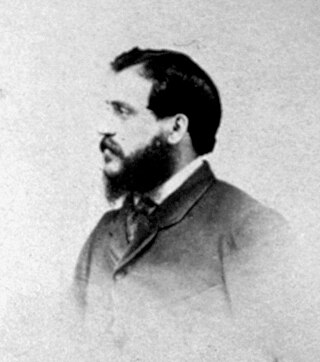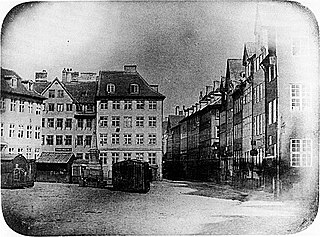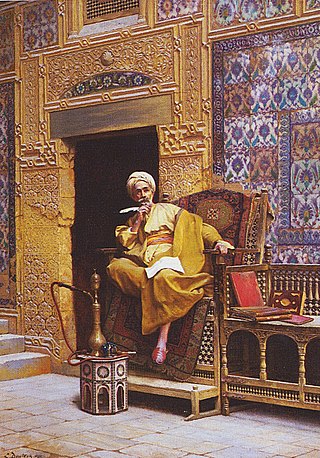Photography in China dates back to the mid-19th century with the arrival of European photographers in Macao. In the 1850s, western photographers set up studios in the coastal port cities, but soon their Chinese assistants and local competition spread to all regions.

Hand-colouring refers to any method of manually adding colour to a monochrome photograph, generally either to heighten the realism of the image or for artistic purposes. Hand-colouring is also known as hand painting or overpainting.

Hippolyte Arnoux was a French photographer and publisher. He was one of the first photographers to produce images of Egypt and documented the Suez Canal project with extensive photographs and a publication.

Félix Adrien Bonfils was a French photographer and writer who was active in the Middle East. He was one of the first commercial photographers to produce images of the Middle East on a large scale and amongst the first to employ a new method of colour photography, developed in 1880.

Adolfo Farsari was an Italian photographer based in Yokohama, Japan. His studio, the last notable foreign-owned studio in Japan, was one of the country's largest and most prolific commercial photographic firms. Largely due to Farsari's exacting technical standards and his entrepreneurial abilities, it had a significant influence on the development of photography in Japan.

Felice Beato, also known as Felix Beato, was an Italian–British photographer. He was one of the first people to take photographs in East Asia and one of the first war photographers. He is noted for his genre works, portraits, and views and panoramas of the architecture and landscapes of Asia and the Mediterranean region. Beato's travels gave him the opportunity to create images of countries, people, and events that were unfamiliar and remote to most people in Europe and North America. His work provides images of such events as the Indian Rebellion of 1857 and the Second Opium War, and represents the first substantial body of photojournalism. He influenced other photographers, and his influence in Japan, where he taught and worked with numerous other photographers and artists, was particularly deep and lasting.

Uchida Kuichi was a pioneering Japanese photographer from Nagasaki. He was greatly respected as a portrait photographer and was the only photographer granted a sitting to photograph the Emperor Meiji.

In Denmark, photography has developed from strong participation and interest in the very beginnings of the art in 1839 to the success of a considerable number of Danes in the world of photography today.
The history of photography in Japan begins in the 19th century and has continued to be a prominent art form into the present era.

The Adelphoi Zangaki, known by their probable initials C. and G. Zangaki, were two brothers of Greek origin, active as photographers in Ottoman Egypt from the 1860s through to the 1890s. They specialized in photographing ancient monuments and scenes of everyday life, producing photographic prints for the tourist trade. They occasionally worked with the French photographer Hippolyte Arnoux in Port Said, documenting the works on the Suez Canal. Further, they were among the first commercial photographers to produce large scale images of late 19th- century Egypt.
The practice of photography in Korea was delayed until the late 19th century, because of the Joseon Dynasty's policy forbidding contact with foreigners.

The participation of women in photography goes back to the very origins of the process. Several of the earliest women photographers, most of whom were from Britain or France, were married to male pioneers or had close relationships with their families. It was above all in northern Europe that women first entered the business of photography, opening studios in Denmark, France, Germany, and Sweden from the 1840s, while it was in Britain that women from well-to-do families developed photography as an art in the late 1850s. Not until the 1890s, did the first studios run by women open in New York City.

The Ouled Naïl are an Arab tribal confederation living in the Ouled Naïl Range, Algeria. They are found mainly in Bou Saâda, M'Sila and Djelfa, but there is also a significant number of them in Ghardaïa.

Ludwig Deutsch was a French painter of Austrian origin, who settled in Paris and became a noted Orientalist artist. Having studied at the Vienna Academy of Fine Arts from 1872 to 1875, he moved to Paris in 1878, where he became associated with other Orientalist painters. Most of his works were painted in his studio in Paris, but he had visited Egypt on several journeys from 1885 to 1898. In 1919, he became a French citizen and started to write his name as Louis Deutsch.

Lai Afong was a Chinese photographer who established Afong Studio, considered to be the most successful photographic studio in the late Qing Dynasty. He is widely acknowledged as the most significant Chinese photographer of the nineteenth century.
Jean Pascal Sébah was a Syriac-Armenian photographer. The son of Pascal Sébah, he continued the Sébah family's photographic legacy after his father's death in 1886.
Lehnert & Landrock was a photographic studio run by Rudolf Franz Lehnert and Ernst Heinrich Landrock active in Tunisia and Egypt in the early 20th century, noted for producing Orientalist images. Rudolf Franz Lehnert and Ernst Heinrich Landrock produced images of North African people, landscapes, and architecture for a primarily European audience. These images were mainly distributed in monographs, though also as original prints, photogravures, and lithographic postcards.
Photography, as a branch of science, technology and art, developed in Ukraine in different ways, as historically lands were divided between two empires: Russia and Austria. This has led to some differences in the goals of photographic societies and in the technological and social role of photography in Ukraine.

Photographs have been taken in the area now known as Canada since 1839, by both amateurs and professionals. In the 19th century, commercial photography focussed on portraiture. But professional photographers were also involved in political and anthropological projects: they were brought along on expeditions to Western Canada and were engaged to document Indigenous peoples in Canada by government agencies.






















